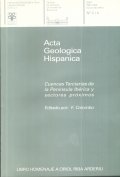Características de las secuencias deposicionales de alta frecuencia en el sistema arrecifal del Mioceno superior de Mallorca
Abstract
Application of sequence stratigraphy concepts in well-exposed prograding carbonate complexes, such as the example of Mallorca, shows marked peculiarities differing from the commonly used as standard model of the Exxon group. These peculiarities are seen in high-frequency sequences bounded by well-definederosion surfaces. The standard model is incomplete in the sense that it shows no sedimentary record of the fall of the sea-level cycle, except for erosion or karstification. In contrast, the Mallorcan example shows more complete and continuous sedimentary record during the entire sea-level cycle: an offlapping package, commonly ignored or misinterpreted, is deposited during the internal of sea-level fall, and considered as a new systems tract. As a result, the most obvious and marked erosion surface separating these high-frequency packages is the sequence boundary. Furthermore, in the standard model the downlap surface is correlative with the maximum flooding surface and a condensed section. In contrast, the Mallorcan model shows that a condensed section and downlap surface are produced during the offlapping systems tract, whereas the maximum flooding surface are indistinct. There are two surfaces easily recognized in the Mallorcan example: an erosion surface and a downlap surface. On this basis there are two major systems packages or tracts: a lower package with aggradation in all the systems formed during sea-level rise and high-stillstand and an upper package with offlapping progradation formed during sea-level fall and low-stillstand. Al1 the above peculiarities of the Mallorcan prograding reef complex show the need for careful application of the dynamic concepts of sequence stratigraphy, rather than the strict reference to the standard scheme. The relationships between carbonate production and each segment of the sea-level cycle explain these departures from the standard 3rd-order sequencemodel developed from siliciclastic deposits on passive margins.


